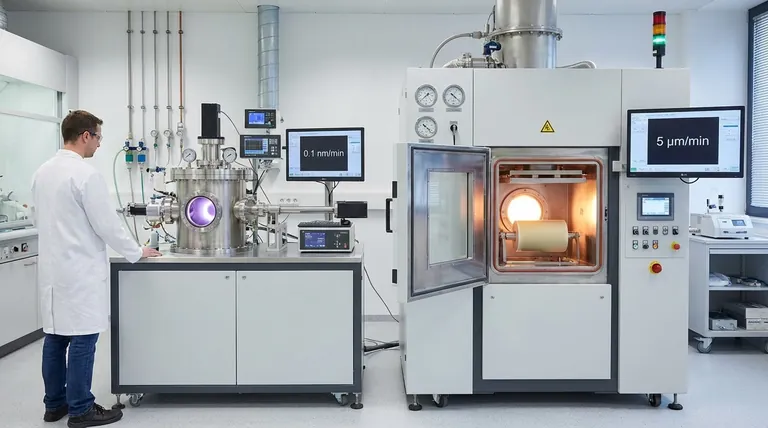There is no single deposition rate for Physical Vapor Deposition (PVD). The rate is not a fixed number but a highly variable outcome that depends entirely on the specific PVD technique being used and the parameters of the process. Rates can range from as slow as 0.1 nanometers per minute for precise optical coatings to as fast as several micrometers per minute for metallization applications.
The central takeaway is that the deposition rate in PVD is not a property of PVD itself, but a result of a specific choice. The question is not "how fast is PVD," but rather, "what factors control the speed of my chosen PVD process?"

Why "PVD" Doesn't Have a Single Rate
Physical Vapor Deposition is a family of different vacuum deposition techniques, not a single monolithic process. Each method has a fundamentally different mechanism for generating vapor from a solid material, which is the primary determinant of the deposition rate.
Asking for the deposition rate of "PVD" is like asking for the top speed of a "vehicle." A bicycle and a fighter jet are both vehicles, but their speeds are determined by entirely different principles. The same is true for PVD.
Key Factors Controlling Deposition Rate
To understand deposition speed, you must look at the specific technique and the variables that govern it.
The PVD Method is the Primary Factor
The choice between methods like thermal evaporation and sputtering creates entirely different ranges of possible deposition rates.
Thermal Evaporation is generally a faster process. The rate is controlled by heating a source material in a vacuum until it evaporates. The primary control knob is temperature; a higher source temperature creates a higher vapor pressure, leading to a much faster deposition rate.
Sputter Deposition is typically a slower, more controlled process. It uses a plasma to bombard a target with ions, knocking atoms loose. The rate is primarily controlled by the plasma power and the pressure of the sputtering gas (like Argon). While slower, it offers superior film density, adhesion, and compositional control.
Source-to-Substrate Distance
PVD is a "line-of-sight" process where vaporized atoms travel from the source to the object being coated. A shorter distance between the source material and the substrate almost always results in a higher deposition rate, as fewer atoms are lost to the chamber walls.
Chamber Pressure
The process occurs in a high vacuum. A lower base pressure (a better vacuum) means there are fewer residual gas molecules for the vaporized atoms to collide with. This leads to a more efficient and direct path to the substrate, often increasing the deposition rate.
Target Material Properties
The material being deposited has a major influence. Materials with a high vapor pressure (like aluminum or zinc) will evaporate much more quickly at a given temperature than refractory metals with low vapor pressure (like tungsten). In sputtering, this is known as the "sputter yield"—some materials eject more atoms per incoming ion than others.
Understanding the Trade-offs
Choosing a PVD method is always a balance between speed and the desired outcome for the thin film.
Speed vs. Quality
This is the most critical trade-off. Faster deposition, common in thermal evaporation, often results in films that are less dense and have poorer adhesion. Slower, more energetic processes like sputtering create higher-quality, more durable, and more uniform films.
Control vs. Simplicity
Sputtering offers extremely fine control over film thickness, uniformity, and even stoichiometry when depositing complex materials like oxides or nitrides. Thermal evaporation is a conceptually simpler process but offers less control over the final film properties.
Making the Right Choice for Your Goal
Your application's requirements should dictate the PVD method you choose, which in turn determines the potential deposition rate.
- If your primary focus is high-throughput metallization (e.g., aluminized films for packaging): Thermal evaporation is often the ideal choice due to its high speed.
- If your primary focus is high-performance optical coatings or semiconductor devices: Sputtering is necessary for the precision, uniformity, and film quality required, even at a slower rate.
- If your primary focus is depositing durable, hard coatings on tools: Cathodic arc deposition or sputtering are used for their excellent adhesion and film density, prioritizing quality over raw speed.
By understanding these core principles, you can shift from asking "how fast?" to determining "what is best?" for your specific application.
Summary Table:
| PVD Method | Typical Deposition Rate Range | Key Controlling Factor |
|---|---|---|
| Thermal Evaporation | 1 - 10 µm/min | Source Temperature |
| Sputter Deposition | 0.1 - 1 µm/min | Plasma Power & Gas Pressure |
| Cathodic Arc | 0.5 - 5 µm/min | Arc Current |
Need to Optimize Your PVD Process for Speed and Quality?
Choosing the right PVD method and parameters is critical for achieving your desired deposition rate and film properties. At KINTEK, we specialize in providing lab equipment and consumables tailored to your specific coating needs—whether you require high-throughput metallization or precision optical coatings.
Our experts can help you select the ideal PVD solution that balances speed, control, and film quality for your application. Contact us today to discuss how we can enhance your laboratory's capabilities and achieve your coating goals!
Visual Guide

Related Products
- RF PECVD System Radio Frequency Plasma-Enhanced Chemical Vapor Deposition RF PECVD
- Split Chamber CVD Tube Furnace with Vacuum Station Chemical Vapor Deposition System Equipment Machine
- Chemical Vapor Deposition CVD Equipment System Chamber Slide PECVD Tube Furnace with Liquid Gasifier PECVD Machine
- VHP Sterilization Equipment Hydrogen Peroxide H2O2 Space Sterilizer
- Molybdenum Tungsten Tantalum Special Shape Evaporation Boat
People Also Ask
- What are the advantages of PECVD? Enable Low-Temperature, High-Quality Thin-Film Deposition
- What are the applications of PECVD? Essential for Semiconductors, MEMS, and Solar Cells
- Why is PECVD environment friendly? Understanding the Eco-Friendly Benefits of Plasma-Enhanced Coating
- How does RF power create plasma? Achieve Stable, High-Density Plasma for Your Applications
- What is an example of PECVD? RF-PECVD for High-Quality Thin Film Deposition



















